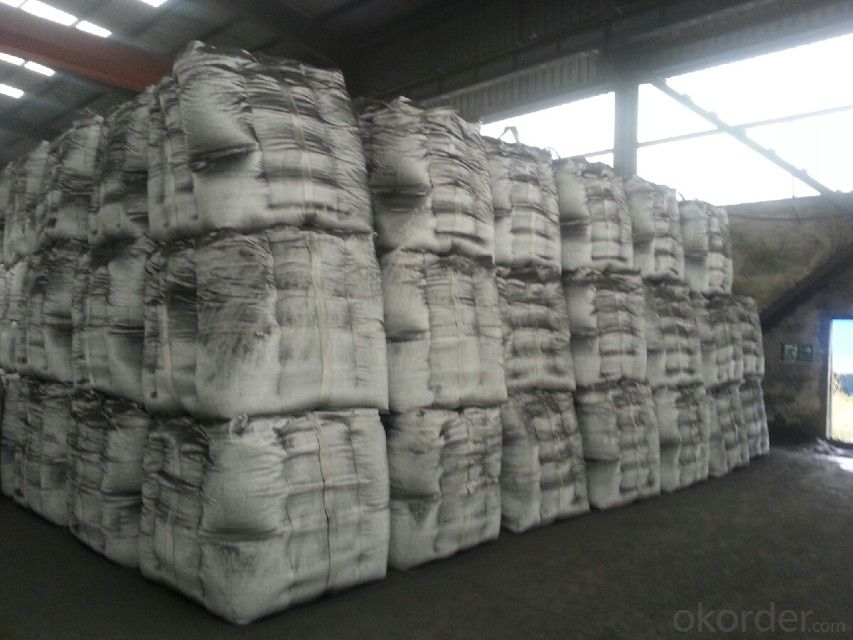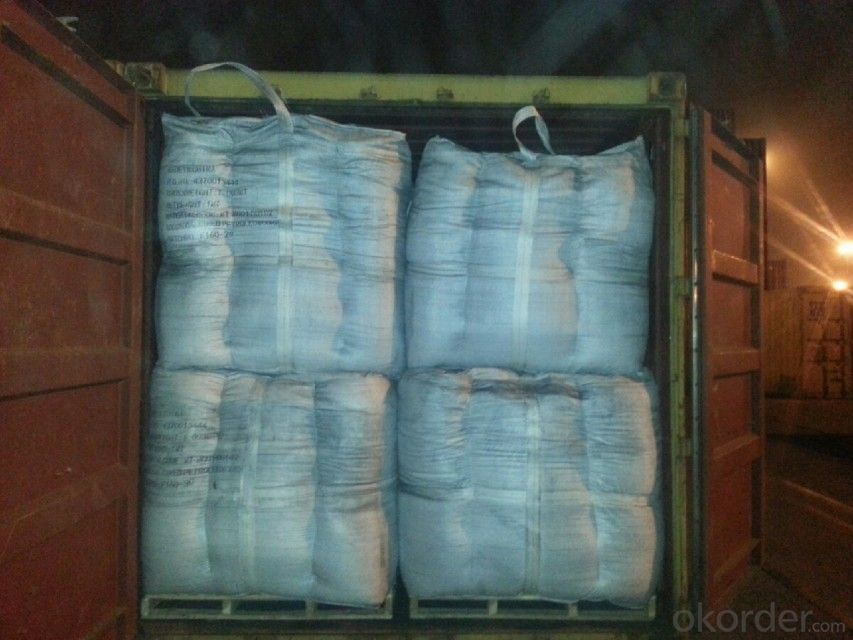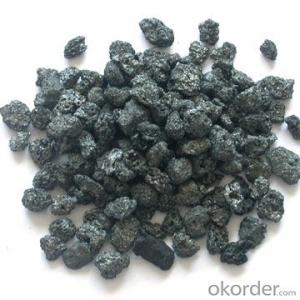Calcined Peroleum Coke with FC 98.5% S 0.7%
- Loading Port:
- Tianjin
- Payment Terms:
- TT OR LC
- Min Order Qty:
- 20 m.t.
- Supply Capability:
- 2000 m.t./month
OKorder Service Pledge
OKorder Financial Service
You Might Also Like
Packaging & Delivery
25kgs/50kgs/1ton per bag or as buyer's request
Calcined Petroleum Coke is a critical ingredient in the production of Metallurgy and chemical industrial ,it can increase the used quantity of Scrap steel and reduce the quantity of Scrap iron, or use no Scrap iron at all, the calcined petroleum coke has follow properties: high absorptive character, no residue will be left and save production cost.
User : Calcined Petroleum Coke comes from delayed coke which extracted from oil refinery. Although Calcined Petroleum Coke contains a little bit higher level of sulfur and nitrogen than pitch coke, the price advantage still makes it widely used during steel-making and founding as a kind of carbon additive/carburant.
General Specification of Calcined Anthracite:
| FC % | 98.5 | 98.5 | 98.5 | 99 |
| ASH % | 0.8 | 0.8 | 0.8 | 0.5 |
| V.M. % | 0.7 | 0.7 | 0.7 | 0.5 |
| S % | 0.5 | 0.55 | 0.7 | 0.5 |
| MOISTURE % | 0.5 | 0.5 | 0.5 | 0.5 |
Standard Sizes (Granulometry):
0-4 mm, 0.5-3 mm, 0-25 mm, 1-4 mm, 2-8 mm We also supply as per customer's requirement.
Picture of CPC/ Calcined Petroleum Coke


- Q:How does carbon contribute to the flavor of food?
- There are multiple ways in which carbon, found in charcoal or charred substances, can enhance the flavor of food. Firstly, when food is cooked over charcoal, the carbon gives it a smoky taste and aroma, which enhances the overall flavor. This smokiness is particularly desirable in dishes such as barbecued meats, vegetables, and certain cheeses, as it adds a unique and enjoyable element to the taste. Additionally, carbon can serve as a natural filter, absorbing and eliminating impurities from food and drinks. This filtration process helps to get rid of unpleasant smells and flavors, resulting in a cleaner and more refined taste. For instance, activated carbon is often used in the production of alcoholic beverages like whiskey or vodka to remove impurities and create a smoother and more flavorful drink. Moreover, carbon can contribute to the development of desirable texture and color in certain foods. When sugar or other carbohydrates are heated, they undergo caramelization, a process in which the sugars react with heat to form a complex mixture of carbon compounds. This caramelization process creates rich, golden-brown hues and a unique depth of flavor, enhancing the overall taste experience. Lastly, carbon plays a crucial role in the fermentation process, which is essential in producing various types of food and drinks. During fermentation, microorganisms consume sugars and release carbon dioxide, which contributes to the texture, flavor, and carbonation of the final product. This is particularly evident in bread, beer, wine, and other fermented foods, where the presence of carbon dioxide adds lightness, complexity, and effervescence to the flavor. To summarize, carbon enhances the flavor of food through its ability to impart smokiness, act as a natural filter, facilitate caramelization, and participate in fermentation processes. Its presence in different forms enhances the taste, texture, and overall enjoyment of a wide range of food and drinks.
- Q:What are the limitations of carbon dating?
- One limitation of carbon dating is that it can only be used to date organic materials up to around 50,000 years old. Additionally, the dating method can be affected by contamination or mixing of materials, which can lead to inaccurate results. Furthermore, carbon dating relies on the assumption that the atmospheric concentration of carbon-14 has remained constant over time, which is not always the case. Finally, carbon dating is not suitable for dating objects that do not contain carbon, such as rocks or minerals.
- Q:What is carbon PC?
- Polycarbonate (PC), polycarbonate is a molecular chain containing [O-R-O-CO] chain thermoplastic resin according to the molecular structure of the ester can be divided into aliphatic, alicyclic and aromatic type of fat, which has the practical value of the aromatic polycarbonate, and bisphenol A polycarbonate as the most important, molecular weight is usually 3-10 million.Polycarbonate, English Polycarbonate, referred to as PC.PC is a kind of amorphous, odorless, non-toxic, highly transparent colorless or slightly yellow thermoplastic engineering plastics, has excellent physical and mechanical properties, especially excellent shock resistance, tensile strength, bending strength, compressive strength and high creep; small size is stable; good heat resistance and low temperature resistance, mechanical properties, stability in a wide range of temperature dimensional stability, electrical properties and flame retardant properties, can be used for a long time at -60~120 deg.c; no obvious melting point, a molten state at 220-230 DEG C; the molecular chain rigidity, melt viscosity and high water absorption resin; small, small shrinkage, high precision, good dimensional stability, permeability of films is small; self extinguishing materials; stable to light, but not UV resistance, good weather resistance; oil resistance, acid and alkali resistance, no oxygen acid and amine, Ketones are soluble in chlorinated hydrocarbons and aromatic solvents. They are easy to cause hydrolysis and cracking in water for a long time. Because of their poor fatigue resistance, they are prone to stress cracking, poor solvent resistance and poor wear resistance
- Q:How dnf advanced carbon ashes?
- That thing is called the advanced furnace rock carbon... Not ash carbon...... It was bought at the mall (sold before, no now), with a success rate plus ten percent.
- Q:What are the impacts of carbon emissions on water scarcity?
- Carbon emissions have significant impacts on water scarcity as they contribute to climate change, which alters precipitation patterns and increases the frequency and intensity of droughts. Additionally, carbon emissions from industrial activities and fossil fuel combustion can lead to water pollution, further exacerbating water scarcity by degrading water quality and reducing available resources for human consumption and agriculture.
- Q:How is carbon used in the production of nanoelectronics?
- Carbon is used in the production of nanoelectronics due to its unique properties. It can be structured into nanoscale materials like carbon nanotubes and graphene, which possess excellent electrical conductivity and mechanical strength. These carbon-based materials are utilized in various components of nanoelectronic devices, such as transistors and sensors, to enhance their performance and efficiency.
- Q:How does carbon affect the quality of indoor air?
- Carbon can have a significant impact on the quality of indoor air. One of the main contributors to carbon in indoor air is carbon dioxide (CO2), which is produced through the process of respiration by humans and animals. High levels of CO2 can cause discomfort, as it can lead to feelings of drowsiness, headaches, and difficulty concentrating. In addition to CO2, carbon monoxide (CO) is another carbon compound that can be present in indoor air, mainly due to the incomplete combustion of fossil fuels in stoves, fireplaces, and furnaces. Carbon monoxide is highly toxic and can be life-threatening if present in high concentrations. Apart from these direct sources of carbon, indoor air can also be affected by volatile organic compounds (VOCs), such as formaldehyde, benzene, and toluene. These VOCs are released from various sources like building materials, furniture, cleaning products, and tobacco smoke. They can have adverse health effects, including eye, nose, and throat irritation, headaches, dizziness, and in some cases, even long-term health risks like cancer. To maintain good indoor air quality, it is essential to monitor and control the levels of carbon compounds in the air. Proper ventilation is crucial to ensure fresh air circulation and reduce the concentration of CO2 and other pollutants. Regular maintenance and inspection of fuel-burning appliances can prevent the build-up of carbon monoxide. Using low-VOC or VOC-free materials and products, as well as avoiding smoking indoors, can help minimize the release of harmful carbon compounds.
- Q:I want to know why the ATP in the five carbon sugar is a DNA RNA??
- An adenosine ribose adenine nucleoside by connection formation.If it is deoxyribonucleic acid, it is called three phosphate adenine nucleoside, or dATP
- Q:How does carbon affect the formation of permafrost thawing?
- Carbon can have a significant impact on the formation of permafrost thawing. Permafrost is a layer of frozen soil, rock, and organic matter that remains at or below freezing for at least two consecutive years. It acts as a natural carbon sink, storing large amounts of organic carbon from dead plants and animals that have accumulated over thousands of years. When permafrost thaws, this stored carbon starts to decompose, releasing greenhouse gases such as carbon dioxide and methane into the atmosphere. The carbon released from permafrost thawing contributes to the overall increase in greenhouse gas concentrations, exacerbating climate change. Additionally, as permafrost thaws, it becomes more vulnerable to erosion and subsidence, leading to changes in the landscape and the release of even more carbon. This process can create a positive feedback loop, where the released carbon further accelerates permafrost thawing, resulting in more carbon emissions. Furthermore, permafrost thawing can also impact the stability of infrastructure built on frozen ground, such as roads, buildings, and pipelines, leading to significant economic and environmental consequences. In summary, carbon plays a crucial role in the formation and thawing of permafrost. The release of carbon from thawing permafrost contributes to climate change, accelerates the thawing process, and has various environmental and economic impacts. Addressing carbon emissions and finding ways to mitigate permafrost thawing is essential to combatting climate change and preserving the stability of these frozen ecosystems.
- Q:What are the main sources of carbon emissions?
- Human activities, particularly the burning of fossil fuels like coal, oil, and natural gas, are primarily attributed as the main sources of carbon emissions. When these fossil fuels are combusted for electricity generation, transportation, and industrial processes, significant amounts of carbon dioxide (CO2) are released into the atmosphere. Deforestation and land-use changes also play a major role in carbon emissions. Clearing or burning forests leads to the release of carbon stored in trees and vegetation as CO2, contributing to greenhouse gas emissions. Moreover, the decrease in forests reduces their ability to absorb carbon dioxide through photosynthesis, worsening the issue. Substantial carbon emissions are also generated by industrial processes such as cement production and chemical manufacturing. Cement production, in particular, produces a significant amount of CO2 due to the chemical reactions involved. Agriculture is another significant source of carbon emissions, primarily through the release of methane (CH4) and nitrous oxide (N2O). Livestock farming, especially cattle, produces methane through enteric fermentation and manure management. Nitrous oxide is released from the use of synthetic fertilizers and manure in agricultural practices. Lastly, waste management and disposal contribute to carbon emissions. Landfills, where organic waste decomposes, release methane gas. Additionally, the incineration of waste also releases CO2 and other greenhouse gases into the atmosphere. To reduce carbon emissions, it is vital to address these primary sources. This can be achieved through transitioning to cleaner energy sources, promoting sustainable land-use practices, improving industrial processes, adopting more sustainable agricultural practices, and implementing effective waste management strategies.
1. Manufacturer Overview |
|
|---|---|
| Location | |
| Year Established | |
| Annual Output Value | |
| Main Markets | |
| Company Certifications | |
2. Manufacturer Certificates |
|
|---|---|
| a) Certification Name | |
| Range | |
| Reference | |
| Validity Period | |
3. Manufacturer Capability |
|
|---|---|
| a)Trade Capacity | |
| Nearest Port | |
| Export Percentage | |
| No.of Employees in Trade Department | |
| Language Spoken: | |
| b)Factory Information | |
| Factory Size: | |
| No. of Production Lines | |
| Contract Manufacturing | |
| Product Price Range | |
Send your message to us
Calcined Peroleum Coke with FC 98.5% S 0.7%
- Loading Port:
- Tianjin
- Payment Terms:
- TT OR LC
- Min Order Qty:
- 20 m.t.
- Supply Capability:
- 2000 m.t./month
OKorder Service Pledge
OKorder Financial Service
Similar products
New products
Hot products




























